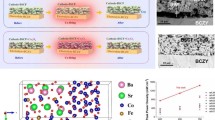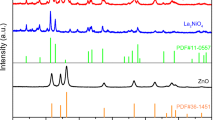Abstract
Solid oxide fuel cells (SOFCs) are facing a bottleneck issue caused by their high operating temperatures that confines their widespread application, which is mainly due to the low ionic conductivity of the electrolyte. If the ionic transport in the electrolyte could be improved to reduce the operating temperatures of SOFCs, their application scenarios could be extended to more industrial activities, such as providing continuous power to Internet of Things (IoT) devices. In this work, as a proof of concept, a new nanocomposite electrolyte NBZY is proposed based on proton conductor BaZr0.8Y0.2O3−δ and Na2CO3 for developing low-temperature SOFCs to power IoT sensors. Material characterization reveals the prepared BaZr0.8Y0.2O3−δ–Na2CO3 (NBZY) forms a heterostructure, with a thin layer of amorphous Na2CO3 coating on the surface of BZY particles, which could create effective pathways to enable high proton conductivity in NBZY. The fabricated NBZY-based SOFCs exhibit high peak power densities of 245–943 mW/cm2 and high open circuit voltages (OCVs) of 1.09 ~ 1.22 V at 400–500 °C due to the high proton conduction and good gas-tightness of NBZY. Durability tests demonstrate that the cells have good operation repeatability and can be stably operated for up to 90 h. Using a power management unit (PMU), the developed SOFC can be used to charge the supercapacitor within 35 min and successfully power the IoT sensor to measure the ambient temperature. This study develops a new high-performance composite electrolyte for low-temperature SOFCs and for the first time indicates the feasibility of SOFC for powering IoT systems.








Similar content being viewed by others

Data availability
The data that support the findings of this study are available from the corresponding author, upon reasonable request.
References
M.A. Perea-Moreno, E. Salmerón-Manzano, A.J. Perea-Moreno, Biomass as renewable energy: worldwide research trends. Sustainability 11, 863 (2019)
B.C. Steele, A. Heinzel, Materials for fuel-cell technologies, in Materials for sustainable energy a collection of peer-reviewed research and review articles from nature publishing group. ed. by V. Dusastre (Co-Published with Macmillan Publishers Ltd, London, 2011), pp.224–231
R.M. Ormerod, Solid oxide fuel cells. Chem. Soc. Rev. 32, 17–28 (2003)
A. Choudhury, H. Chandra, A. Arora, Application of solid oxide fuel cell technology for power generation—a review. Renew. Sust. Energy Rev. 20, 430–442 (2013)
K. Kendall, M. Palin, A small solid oxide fuel cell demonstrator for microelectronic applications. J. Power Sour. 71, 268–270 (1998)
J. Fan, C. Fu, H. Yin, Y. Wang, Q. Jiang, Power transformer condition assessment based on online monitor with SOFC chromatographic detector. Int. J. Electr. Power Energy Syst. 118, 105805 (2020)
J. Fan, Y. Lu, J. Ding, A. Meng, Z. Tang, J. Ye, SOFC detector with OCA approach to quantify trace gases dissolved in transformer oil. IEEE Sens. J. 20, 648–655 (2019)
H. Sumi, S. Nakabayashi, T. Kawada, Y. Uchiyama, N. Uchiyam, K. Ichihara, Demonstration of SOFC power sources for drones (UAVs; unmanned aerial vehicles). ECS Trans. 91, 149 (2019)
R.J. Milcarek, K. Wang, R.L. Falkenstein-Smith, J. Ahn, Micro-tubular flame-assisted fuel cells for micro-combined heat and power systems. J. Power Sour. 306, 148–151 (2016)
H. Lv, Z. Huang, G. Zhang, T. Chen, S. Wang, A new design of metal supported micro-tubular solid oxide fuel cell with sandwich structure. Int. J. Hydrog. Energy 47, 33420–33428 (2022)
R. Veerubhotla, S. Nag, D. Das, Internet of Things temperature sensor powered by bacterial fuel cells on paper. J. Power Sour. 438, 226947 (2019)
P. Rewatkar, D. Nath, U.S. Jayapiriya, S. Dudala, S. Goel, Self-powered real-time monitoring of environmental conditions by arrayed Al-air origmai fuel cell. J. Power Sour. 549, 232127 (2022)
E. Osorio de la Rosa, J. Vázquez Castillo, M. Carmona Campos, G.R. Barbosa Pool, G. Becerra Nuñez, A. Castillo Atoche, J. Ortegón Aguilar, Plant microbial fuel cells-based energy harvester system for self-powered IoT applications. Sensors 19, 1378 (2019)
E.D. Wachsman, K.T. Lee, Lowering the temperature of solid oxide fuel cells. Science 334, 935–939 (2011)
M. Fallah Vostakola, B. Amini Horri, Progress in material development for low-temperature solid oxide fuel cells: a review. Energies 14, 1280 (2021)
N. Jaiswal, K. Tanwar, R. Suman, D. Kumar, S. Upadhyay, O. Parkash, A brief review on ceria based solid electrolytes for solid oxide fuel cells. J. Alloys Compds. 781, 984–1005 (2018)
K. Kerman, B.K. Lai, S. Ramanathan, Nanoscale compositionally graded thin-film electrolyte membranes for low-temperature solid oxide fuel cells. Adv. Energy Mater. 2, 656–661 (2012)
Y. Yoo, N. Lim, Performance and stability of proton conducting solid oxide fuel cells based on yttrium-doped barium cerate-zirconate thin-film electrolyte. J. Power Sour. 229, 48–57 (2013)
J. Qian, W. Sun, Q. Zhang, G. Jiang, W. Liu, Fabrication and performance of BaCe0.8Y0.2O3-δ–BaZr0.8Y0.2O3-δ bilayer electrolyte for anode-supported solid oxide fuel cells. J. Power Sour. 249, 131–136 (2014)
N.T. Nguyen, H.H. Yoon, Preparation and evaluation of BaZr0.1Ce0.7Y0.1Yb0.1O3−δ (BZCYYb) electrolyte and BZCYYb-based solid oxide fuel cells. J. Power Sour. 231, 213–218 (2013)
D. Pergolesi, E. Fabbri, A. D’Epifanio, E. Di Bartolomeo, A. Tebano, S. Sanna, S. Licoccia, G. Balestrino, E. Traversa, High proton conduction in grain-boundary-free yttrium-doped barium zirconate films grown by pulsed laser deposition. Nat. Mater. 9, 846–852 (2010)
E. Fabbri, D. Pergolesi, E. Traversa, Materials challenges toward proton-conducting oxide fuel cells: a critical review. Chem. Soc. Rev. 39, 4355–4369 (2010)
M.A. Mahdi, S.R. Yousefi, L.S. Jasim, M. Salavati-Niasari, Green synthesis of DyBa2Fe3O7.988/DyFeO3 nanocomposites using almond extract with dual eco-friendly applications: photocatalytic and antibacterial activities. Int. J. Hydrog. Energy 47, 14319–14330 (2022)
S.R. Yousefi, H.A. Alshamsi, O. Amiri, M. Salavati-Niasari, Synthesis, characterization and application of Co/Co3O4 nanocomposites as an effective photocatalyst for discoloration of organic dye contaminants in wastewater and antibacterial properties. J. Mol. Liq. 337, 116405 (2021)
B. Zhu, L. Fan, P. Lund, Breakthrough fuel cell technology using ceria-based multi-functional nanocomposites. Appl. Energy 106, 163–175 (2013)
L. Fan, C. Wang, M. Chen, B. Zhu, Recent development of ceria-based (nano) composite materials for low temperature ceramic fuel cells and electrolyte-free fuel cells. J. Power Sour. 234, 154–174 (2013)
Y. Ma, X. Wang, R. Raza, M. Muhammed, B. Zhu, Thermal stability study of SDC/Na2CO3 nanocomposite electrolyte for low-temperature SOFCs. Int. J. Hydrog. Energy 35, 2580–2585 (2010)
B. Zhu, B. Functional, ceria-salt-composite materials for advanced ITSOFC applications. J. Power Sour. 114, 1–9 (2003)
X. Wang, Y. Ma, S. Li, A.H. Kashyout, B. Zhu, M. Muhammed, Ceria-based nanocomposite with simultaneous proton and oxygen ion conductivity for low-temperature solid oxide fuel cells. J. Power Sour. 196, 2754–2758 (2011)
X. Wang, Y. Ma, R. Raza, M. Muhammed, B. Zhu, Novel core-shell SDC/amorphous Na2CO3 nanocomposite electrolyte for low-temperature SOFCs. Electrochem. Commun. 10, 1617–1620 (2008)
L. Fan, B. Zhu, S. Pei-Chen, C. He, Nanomaterials and technologies for low temperature solid oxide fuel cells : recent advances, challenges and opportunities. Nano Energy 45, 148–176 (2018)
S.D.T. Kelly, N.K. Suryadevara, S.C. Mukhopadhyay, Towards the implementation of IoT for environmental condition monitoring in homes. IEEE Sens. J. 13, 3846–3853 (2013)
M.T. Lazarescu, Design of a WSN platform for long-term environmental monitoring for IoT applications. IEEE J. Emerg. Sel. Top. Circ. Syst. 3, 45–54 (2013)
G. Mois, S. Folea, T. Sanislav, Analysis of three IoT-based wireless sensors for environmental monitoring. IEEE Trans. Instrum. Meas. 66, 2056–2064 (2017)
F.J. Romero, A. Rivadeneyra, V. Toral, E. Castillo, F. García-Ruiz, D.P. Morales, N. Rodriguez, Design guidelines of laser reduced graphene oxide conformal thermistor for IoT applications. Sens. Actuators, A Phys. 274, 148–154 (2018)
M.B. Kulkarni, P.K. Yashas, K. Enaganti, S.G. Amreen, Internet of Things enabled portable thermal management system with microfluidic platform to synthesize MnO2 nanoparticles for electrochemical sensing. Nanotechnology 31, 425504 (2020)
Y. Akimoto, H. Takezawa, Y. Iijima, S.N. Suzuki, K. Okajima, Comparative analysis of fuel cell and battery energy systems for internet of things devices. Energy Rep. 6, 29–35 (2020)
M.D. Gonçalves, P.S. Maram, R. Muccillo, A. Navrotsky, Enthalpy of formation and thermodynamic insights into yttrium doped BaZrO3. J. Mater. Chem. A. 2, 17840–17847 (2014)
M. Akbar, B. Jin, Z. Tu, J. Gao, M. Yousaf, N. Mushtaq, X. Wang, W. Dong, B. Wang, Y. Cai, C. Xia, High-performing and stable non-doped ceria electrolyte with amorphous carbonate coating layer for low-temperature solid oxide fuel cells. Electrochim. Acta 393, 139067 (2021)
A.V. Arefiev, I.V. Podborodnikov, A.F. Shatskiy, K.D. Litasov, Synthesis and Raman spectra of K-Ca double carbonates: K2Ca(CO3)2 bütschliite, fairchildite, and K2Ca2(CO3)3 at 1 Atm. Geochem. Int. 57, 981–987 (2019)
Y. Ma, B. He, J. Wang, M. Cheng, X. Zhong, J. Huang, Porous/dense bilayer BaZr0.8Y0.2O3-δ electrolyte matrix fabricated by tape casting combined with solid-state reactive sintering for protonic ceramic fuel cells. Int. J. Hydrog. Energy 46, 9918–9926 (2021)
N. Sata, N.Y. Jin-Phillipp, K. Eberl, J. Maier, Solid State Ion. 154, 497–502 (2002)
J. Maier, Ionic transport in nano-sized systems. Solid State Ion. 175, 7–12 (2004)
R. Zhang, G. Chen, Z. Chen, R. Dai, X. Lv, T. Lou, Y. Li, S. Geng, Investigation of the sudden drop of electrolyte conductivity at low temperature in ceramic fuel cell with Ni0.8Co0.15Al0.05LiO2 electrode. Int. J. Hydrog. Energy 46, 27793–27800 (2021)
D. Yang, G. Chen, H. Liu, L. Zhang, Y. He, X. Zhang, K. Yu, S. Geng, Y. Li, Electrochemical performance of a Ni0.8Co0.15Al0.05LiO2 cathode for a low temperature solid oxide fuel cell. Int. J. Hydrog. Energy 46, 10438–10447 (2021)
Funding
The Science and Technology Project of State Grid Inner Mongolia Eastern Power Co., LTD. Grant no. SGMDHBOOYJJSJ100S90, Tianlong Bu.
Author information
Authors and Affiliations
Contributions
HK and TB conceived and designed the experiments; HK, TB, DN and HH performed the experiments; HK, TB, DN. and HH analyzed the data; HK and TB contributed the used materials and analysis tools; HK, TB and KW wrote the paper. All authors have read and agreed to the published version of the manuscript. All authors have read and agreed to the published version of the manuscript.
Corresponding author
Ethics declarations
Conflict of interest
The authors declared that there is no conflict of interest in this work.
Additional information
Publisher's Note
Springer Nature remains neutral with regard to jurisdictional claims in published maps and institutional affiliations.
Rights and permissions
Springer Nature or its licensor (e.g. a society or other partner) holds exclusive rights to this article under a publishing agreement with the author(s) or other rightsholder(s); author self-archiving of the accepted manuscript version of this article is solely governed by the terms of such publishing agreement and applicable law.
About this article
Cite this article
Kou, H., Bu, T., Nie, D. et al. High-performance LT-SOFCs based on BaZr0.8Y0.2O3−δ–Na2CO3 nanocomposite electrolyte for powering IoT system. J Mater Sci: Mater Electron 35, 426 (2024). https://doi.org/10.1007/s10854-024-12152-z
Received:
Accepted:
Published:
DOI: https://doi.org/10.1007/s10854-024-12152-z



